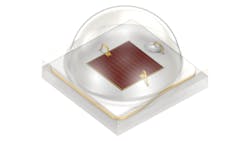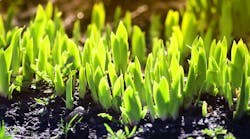The horticultural lighting industry looks determined to shake its current business slowdown. Not only is it ramping an educational push, it also continues to introduce new products. Case in point: ams Osram this month added two red LEDs, claiming improved efficiency and other benefits.
The Austrian LED maker replaced its previous 660nm RM5 “Hyper Red” chip with a new generation RM6 version that the company says offers a 78.8% wall plug efficiency (at a junction temperature of 25°C), compared with 76.8% for the previous model. The new RM6 has a peak wavelength of 660nm and a dominant wavelength of 640nm.
The electricity reduction comes about from an increase in PPF (photosynthetic photon flux) efficacy to 4.32 μmol/J at 700mA, up from 4.20 µmol/J on the RM5.
“The differences may seem small,” a spokesperson for the Premstaetten-based company acknowledged to LEDs Magazine. “However, in real-life scenarios, utilizing the RM6 can result in saving up to 18% in LED costs or increasing output by 21% when compared to the RM5.”
Efficiency improvements are especially important at the moment because high global energy prices have discouraged growers from implementing new artificial lighting, prompting a downturn in sales of horticultural LEDs as many farms decide to rely on natural light only — without supplemental artificial illumination — and as some operators decide against all-indoor vertical farms.
The slowdown has galvanized the LED industry into a drive to educate growers and the public on the advantages of horticultural lighting, including the role it can play in establishing global food security.
The new Hyper Red chip is part of ams Osram’s Oslon Square family of products, which uses a 2mm² die, twice the size of the company’s 1mm² Oslon Optimal family.
“A larger chip enables higher efficacy values,” the spokesperson told LEDs. “The Oslon Square is focused on highest efficacy applications for greenhouse toplighting, or vertical farming solutions.”
That is not to say that the company is neglecting the smaller-die Oslon Optimal family.
Within a day of refreshing the Oslon Square lineup, ams Osram also added a 640nm Optimal model, the first ever of its chips at that specific peak wavelength. The dominant wavelength is 630nm.
With the addition, ams Osram now offers a broader range of reddish peak wavelengths that include 640nm, 660nm, and the 730nm far red, which also belongs to the Optimal family. In the Optimal family, Ams Osram also makes a 450nm “Deep Blue” chip and a “horti white” LED.
“Initial research conducted by Wageningen University on behalf of ams Osram shows that a double red peak (640nm and 660nm) in combination with horti white increases the dried biomass level in indoor growing environments,” ams Osram claimed. “In addition, the use of the Oslon Optimal Red helps prevent photo bleaching in some plant varieties. Experience shows that it can also prevent the incidence of fungal and bacterial infection in leafy greens such as basil.”
Wageningen University & Research (WUR) is a Dutch research center that has worked with several LED and lighting companies. For example, in a recent study with Signify, it found that far-red wavelengths can improve tomato yields, but the spectral mix adds to energy costs. WUR has also worked with Current to show that interlighting — placing lights within crops in greenhouses — can increase yields.
Ams Osram declined to reveal pricing of the two new chips.
In another recent enhancement of horticultural offerings, Signify teamed with German engineering and IT giant Siemens to provide enriched data and automation services.
MARK HALPER is a contributing editor for LEDs Magazine, and an energy, technology, and business journalist ([email protected]).
Follow our LinkedIn page for our latest news updates, contributed articles, and commentary, and our Facebook page for events announcements and more. You can also find us on Twitter.





